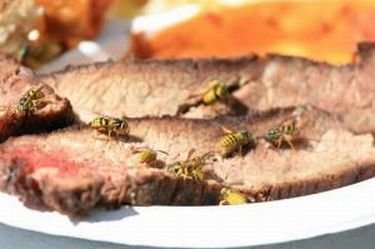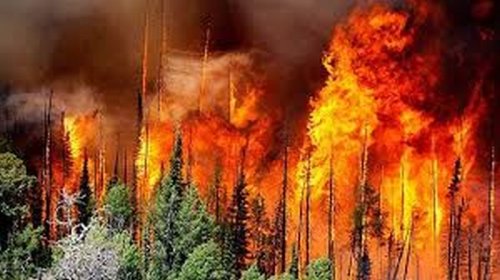Yellow Jackets, Not Bees, Spoiling Seasonal Outdoor Dining in Oregon
With the threat of a painful sting and the nuisance of having them hang around your food, it’s easy to forget that yellow jackets and wasps can also be beneficial insects.

(SALEM, Ore. ) — As an entomologist and pesticide expert for the Oregon Department of Agriculture, Rose Kachadoorian took an active interest while observing a customer of a local home and garden center who was trying to decide which pesticide product to purchase for control of bees.
“When I talked with her, she indicated that yellow jackets were a nuisance as her family tried to enjoy eating outdoors on the patio and that she wanted something to spray on her plants and flowers to kill the bees,” says Kachadoorian. “It was clear to me that she thought of yellow jackets and bees as the same, and that many other Oregonians might have the same confusion.”
A lot of people may think anything that buzzes and stings is a bee. But there is a big difference between wasps or yellow jackets and the common bees still busy pollinating this time of year. Honeybees and bumblebees are not the ones coming after your dinner plate.
“Right now, wasps and yellow jackets are busy looking for protein-rich food and that’s why they are coming to our dinner table when we dine outside,” says Helmuth Rogg, manager of ODA’s Insect Pest Prevention and Management Program. “They are producing queens that will be overwintering, so they need a lot of food. If you have yellow jackets showing up, there’s a good chance you have a nest within a quarter of a mile.”
Step one for any pest problem is proper identification. Yellow jackets are heavy-bodied and distinctively striped yellow and black. Wasps, which have similar coloring, have a small connection between the thorax and abdomen. Both don’t make as much of a buzzing sound as the honeybee.
“The bright yellow color is nature’s warning sign to birds and other animals to stay away from this stinging insect,” says Rogg.
The life cycle of the yellow jacket explains the late summer flurry of activity. Most of the summer, workers, drones, and queens live in underground hives or colonies. The queen lays eggs at a prolific rate and workers take on the job of feeding the brood by foraging for food, primarily meat and fruit.
In late summer, the foraging becomes even greater. In October and November, the workers die out, the queen mates with the drone, and the queen then looks for a place to overwinter. But for now, yellow jacket nests have grown to hundreds or thousands of workers.
“Yellow jackets are generally not overly aggressive, but they are certainly more aggressively looking for food this time of year and defending their nests as we get down to the last few warm days of the year and as they get busy taking care of their queens,” says Rogg.
People also want to make good use of the last few warm days of the year by dining outdoors, whether it’s a picnic, a barbecue, or simply taking the family meal to the backyard patio.
There are steps homeowners can take and there are steps they definitely should not take. Spraying a pesticide product on flowers or plants won’t do anything to control yellow jackets and wasps but will cause great harm to bees who are still looking for nectar and pollen.
Also, don’t try this at home – spraying an aerosol can of pesticides in an opening to a discovered nest. You’ve heard the term “stirring up a hornet’s nest”? That’s not a good thing and hundreds if not thousands of angry, stinging insects will be looking for the instigator.
So what is a homeowner to do when there may be a yellow jacket nest nearby? Rogg says skunks are one of the exceptions of an animal that is often a good control measure as they seek the protein-rich brood and seem immune to retaliatory yellow jackets. But not everyone has a pet skunk. The safest and most practical option is to call in the professionals.
“There are a lot of different pests that homeowners can treat themselves, but I would not put yellow jackets in that category,” says Kachadoorian. “Many times, the professionals wear a suit and goggles because of the threat of stinging. Pesticide applications are often done at night when the insect activity is reduced. Even after treatment, someone will have to come back and dig up the nest to expose the larvae so you don’t get continued development.”
Another option to at least slow down some of the yellow jacket activity is to purchase and erect traps that contain a bait to lure the insect. Once inside the trap, they don’t escape and eventually die.
“These traps attract the workers, but won’t kill the nest,” says Kachadoorian. “At least you can reduce the population level of yellow jackets. Don’t place traps too close to where you will eat, but around the perimeter of your yard. If you know you are having a backyard meal or event, you can plan ahead and use a number of these traps. Personally, I have six of them around the perimeter of my house.”
While these non-toxic traps contain a synthetic lure to attract worker yellow jackets, meat or fruit juice is often used to enhance the attraction.
Directing the yellow jackets away from your meal is advisable. Preventing them from being attracted to the outdoor dinner table may help as well, according to Kachadoorian.
“Don’t wear bright colored clothing, don’t wear perfume, cover food on the table as much as possible so that any yellow jacket in the area doesn’t go back and tell their friends about a good place to eat. Yellow jackets also hover over garbage cans, so make sure to have a good lid. Pick up uneaten pet food or perhaps avoid serving pet food outdoors. Generally, minimize any food that might attract yellow jackets.”
With the threat of a painful sting and the nuisance of having them hang around your food, it’s easy to forget that yellow jackets and wasps can also be beneficial insects. As predators, they will feast on caterpillars or insect life stages that might otherwise harm plants and crops. That probably counts for very little when your outdoor feast is interrupted by an unwanted dinner guest from the insect world.



